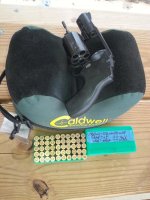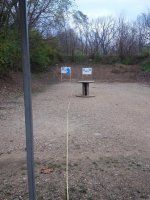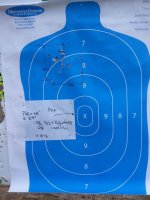What constitutes a good SD depends in large part on the cartridge, the barrel length and the velocities involved.
For example in a high velocity role round an SD of 10 to 15 is excellent. Thats because with an average velocity in the 3000 fps range an SD of 15 fps represents just 0.5% variation.
For a long range precision rifle I will generally reject a load that shows an SD more than 20 fps. ***See below
Short barrels tend to increase SD due to more variation in how much powder will be completely consumed during the shot.
As noted above, lower load densities also introduce more variation in the ignition and burn rate of the powder which increases SD.
Loads with very low load density can be problematic with some powders and can produce pressure spikes. A very high SD is a good thing to be aware of as the higher the SD the greater the risk of a pressure spike and if I'm getting SDs in the >50 fps range, I immediately halt the load development in that direction.
Near maximum loads often display better SDs than light loads for due to ore efficient ignition and burning, but that's also dependent on the powder being consistently burned in the available bore volume. If you start blowing partially burnt powder out the muzzle, and it's not happening in a really consistent manner then SD will increase.
Similarly, as the load approaches near maximum loads some loads can begin to show an increase in SD, which often precedes pressure spiking, just like it does at the low end of the spectrum.
---
In my .38 Special target loads (3.2 gr of Red Dot with a 158 gr LSWC) I normally see an SD of 10 fps even in a 3" barrel, and still around 13 fps in a 1 7/8" barrel. That's excellent in a short barrel and generally reflects excellent accuracy.
In my .38 +P self defense loads with a 125 gr XTP I see somewhat higher SD in the 20 fps range. That's still very good for a short barrel revolver however.
I've tested a few factory loads in my .357 magnums that will display SDs in the 5-8 fps range in a 6" barrel and that is excellent by any standard.
---
Most shooters have a very poor understanding of standard deviation and extreme spread. And they fail to understand how the two are related.
In my 25 or so years of chronographing loads, I've noted that it follows a normal distribution curve quite well.
This means that if you fire 1000 rounds:
680 of them will have velocities within +/- 1 SD of the mean velocity.
950 of them will have velocities within +/- 2 SD of the mean; and
997 of them will have velocities within +/- 3 SD of the mean.
That scales just as well to 100 rounds fired with 68, 95 and essentially 100 rounds falling within plus or minus 1, 2 and 3 SD of the mean.
In other words if my long range .308 load has and SD of 10 fps and an average velocity of 2600 fps, then I know that of 100 rounds fired:
68 rounds will have velocities between 2590 and 2610 fps, with 34 rounds between 2590 and 2600 fps and 34 rounds with velocities between 2600 and 2610 fps;
27 rounds will have velocities between 2580 and 2590 fps and 2610 and 2620 fps, again with about half in each range.
5 rounds will have velocities between 2570 and 2580 fps and 2620 and 2620 fps, once again with about half in each range.
This means all the rounds will fall between 2570 fps and 2630 fps, producing an extreme spread of 60. Or without all the numbers, 6 times the standard deviation.
In that regard, you're better off throwing out the ES on any sample sampler than 100 as you need a larger sample to finally get all the high and low outliers you need to get a reliable ES. Given that only 5 of 100 rounds will fall in the 3rd SD, and half of those will be high and low, you may need to fire more than 50 rounds if there 2 or 3 rounds fired in that 50 rounds that you'd expect to be in the 3rd SD are all in the high or low range of the 3rd SD. That can produce very misleading results and you'll now be using a 2nd SD value for the other end of the ES.
----
***Now for a long range precision rifle load, I like an SD of 10 as it means all the rounds will be departing the muzzle at no more than +/- 30 fps of the average velocity. That equates to less vertical dispersion at long range as well as less horizontal dispersion when the wind is blowing.
If I am zeroed at 100 yards and shooting at a target at 800 yards a 168 gr SMK at 2,600 fps will theoretically drop 27.2 MOA and drift 7 MOA downwind in a 10 mph full value cross wind.
The low 3rd SD shot at a velocity of only 2,570 fps will drop 28 minutes and drift 7.1 minutes.
The high SD shot at a velocity of 2,630 fps will drop 26.5 minutes and drift 6.9 minutes.
That's an extreme spread of only .1 MOA in drift and 1.5 MOA in elevation (12.5" at 800 yards). More importantly, it's no more than .8 MOA from point of aim for any of the worst 5 out of 100 rounds fired (6.7" at 800 yards).
The highest velocity 2nd SD shot will drop 26.8 MOA and the lowest velocity 2nd SD shot will drop 27.7 MOA, meaning 95 out of 100 shots will theoretically be within .5 MOA of point of aim.
That small difference will be lost in the noise of dispersion due to the rifle, and wind and range estimation errors.
But you can't say the same thing about a load with an SD of 40, no matter how accurate it is as that SD of 40 equates to high and low velocities of 2480 fps and 2720 fps, producing 30.4 MOA and 24.5 MOA of drop respectively, a range of 5.9 MOA, which is 49 inches at 800 yards.
---
The effects of high SD on accurate pistol and revolver shooting are just as bad, but for different reasons.
In a pistol or revolver, a low SD also means very consistent recoil and recoil affects point of impact, particularly in a light, short barrel revolver. If you're got an SD of 50 fps in a revolver, that means the velocity will vary by as much as 100 fps in the best 2/3 rds of the rounds fired. That effects recoil which effects point of impact, and while the trajectory different itself might not be that important out to 50 yards or so, the angle of departure differences due to differences in recoil will cause much larger groups.
Which is to say, that a high SD is a bad thing to have, even at ranges under 25 yards, if you're looking for small group sizes.
I do well in the snubby shoots on this site, and attention to SD is one of the reasons.
----
Someone above mentioned that you need at least five 10 shot groups to create a reliable "average" ES.
Well...50 rounds isn't a bad same size but for most statistical purposes a sample size of 30 will give a very reliable SD and from that you can calculate a very reliable ES.
Consequently, I recommend firing three 10 shot groups and combining all the measured velocities into a single 30 shot sample to produce a reliable SD number.
For example, here are the SDs for three 10 shot groups fired in my 20" Model 92 in .357 Magnum with 125 gr XTPs:
17.54
27.93
14.47
The SD for all 30 shots is 20.98 (compared to 19.98 if you average the three SDs).
The high and low velocities were 2,213 and 2,120 fps, with an extreme spread of 93 fps, which suggests that 30 rounds is not sufficient to determine an accurate SD, which we would expect to be around 126 fps, based on the 21 fps SD.
The SD with a 30 shot sample works however as it gives a very reliable measure of central tendency and dispersion without having to shoot enough rounds to actually get the high and low +/- 3 standard deviation outliers you need to get a meaningful ES number.
That's basically why the military requires 30 round groups for ammo acceptance testing, and they repeat the test twice to ensure consistency in the lot.



